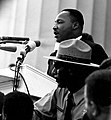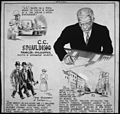The civil rights movement portal The civil rights movement was a social movement and campaign in the United States from 1954 to 1968 which aimed to abolish legalized racial segregation, discrimination, and disenfranchisement in the country, which was most commonly employed against African Americans. The movement had origins in the Reconstruction era during the late 19th century, and had modern roots in the 1940s. After years of direct actions and grassroots protests, the movement made its largest legislative and judicial gains during the 1960s. The movement's major nonviolent resistance and civil disobedience campaigns eventually secured new protections in federal law for the civil rights of all Americans. After the American Civil War and subsequent abolition of slavery in the southern states in 1865, the three Reconstruction Amendments to the United States Constitution had granted emancipation and constitutional rights of citizenship to all African Americans, the majority of whom had recently been enslaved. For a short period of time, African-American men voted and held political office, but as time went on Blacks in the South were increasingly deprived of civil rights, often under racist Jim Crow laws, and were subjected to discrimination and sustained violence by White supremacists. African Americans who moved to the North to enhance their prospects in the Great Migration also faced barriers in employment and housing. Over the following century, various efforts were made by African Americans to secure their legal and civil rights, such as the civil rights movements of 1865–1896 and of 1896–1954. The movement was characterized by nonviolent mass protests and civil disobedience following highly publicized events such as the lynching of Emmett Till in 1955. These included boycotts such as the Montgomery bus boycott, "sit-ins" in Greensboro and Nashville, a series of protests during the Birmingham campaign, and a march from Selma to Montgomery. The movement was led by Martin Luther King Jr., and press coverage of police violence against protesters with fire hoses and dogs during the Birmingham campaign increased its public support. Discrimination was often supported by courts, including by the Supreme Court in its 1896 decision Plessy v. Ferguson, which upheld the doctrine of separate but equal. At the culmination of a legal strategy pursued by African Americans, in 1954 the Supreme Court struck down the underpinnings of laws that allowed racial discrimination as unconstitutional in Brown v. Board of Education. The Warren Court made further pro–civil rights rulings in cases such as Browder v. Gayle (1956) and Loving v. Virginia (1967), banning segregation in public schools and public transport, and striking down all state laws against interracial marriage. Following the March on Washington in 1963, moderates in the movement worked with the United States Congress to achieve the passage of several significant pieces of federal legislation that authorized oversight and enforcement of civil rights laws. The Civil Rights Act of 1964 banned all discrimination based on race, color, religion, sex, and national origin, including in schools, employment, and public accommodations. The Voting Rights Act of 1965 restored and protected voting rights for minorities and authorized oversight of registration and elections in areas with historic under-representation of minority voters. The Fair Housing Act of 1968 forbade property owners from discriminating in the rental or sale of housing. (Full article...) Selected article -The Voting Rights Act of 1965 is a landmark piece of federal legislation in the United States that prohibits racial discrimination in voting. It was signed into law by President Lyndon B. Johnson during the height of the civil rights movement on August 6, 1965, and Congress later amended the Act five times to expand its protections. Designed to enforce the voting rights protected by the Fourteenth and Fifteenth Amendments to the United States Constitution, the Act sought to secure the right to vote for racial minorities throughout the country, especially in the South. According to the U.S. Department of Justice, the Act is considered to be the most effective piece of federal civil rights legislation ever enacted in the country. The National Archives and Records Administration stated: "The Voting Rights Act of 1965 was the most significant statutory change in the relationship between the federal and state governments in the area of voting since the Reconstruction period following the Civil War". The act contains numerous provisions that regulate elections. The act's "general provisions" provide nationwide protections for voting rights. Section 2 is a general provision that prohibits state and local government from imposing any voting rule that "results in the denial or abridgement of the right of any citizen to vote on account of race or color" or membership in a language minority group. Other general provisions specifically outlaw literacy tests and similar devices that were historically used to disenfranchise racial minorities. The act also contains "special provisions" that apply to only certain jurisdictions. A core special provision is the Section 5 preclearance requirement, which prohibited certain jurisdictions from implementing any change affecting voting without first receiving confirmation from the U.S. attorney general or the U.S. District Court for D.C. that the change does not discriminate against protected minorities. Another special provision requires jurisdictions containing significant language minority populations to provide bilingual ballots and other election materials. Section 5 and most other special provisions applied to jurisdictions encompassed by the "coverage formula" prescribed in Section 4(b). The coverage formula was originally designed to encompass jurisdictions that engaged in egregious voting discrimination in 1965, and Congress updated the formula in 1970 and 1975. In Shelby County v. Holder (2013), the U.S. Supreme Court struck down the coverage formula as unconstitutional, reasoning that it was obsolete. The court did not strike down Section 5, but without a coverage formula, Section 5 is unenforceable. The jurisdictions which had previously been covered by the coverage formula massively increased the rate of voter registration purges after the Shelby decision. (Full article...) General imagesThe following are images from various civil rights movement-related articles on Wikipedia.
Related portalsWikiProjectsSelected biography -Charlotte L. Brown (1839–?) was an American educator and civil rights activist who was one of the first to legally challenge racial segregation in the United States when she filed a successful lawsuit against a streetcar company in San Francisco in the 1860s after she was forcibly removed from a segregated streetcar. Brown's legal action and the precedent it created led to additional challenges to segregation in San Francisco and within 30 years, California enacted legislation to make such segregation on streetcars illegal statewide. (Full article...) Selected image - A. Philip Randolph and other civil rights leaders on their way to Congress during the March on Washington, 1963.
Did you know?
TopicsSubcategoriesThings to doAssociated WikimediaThe following Wikimedia Foundation sister projects provide more on this subject:
Discover Wikipedia using portals
|





















































